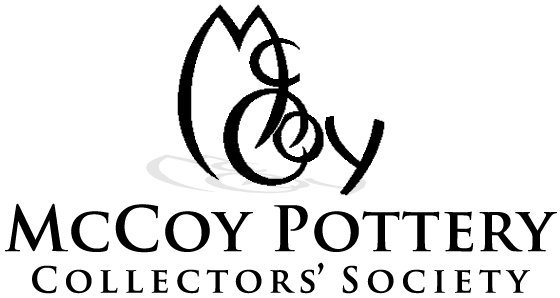Information on Nelson McCoy Fakes & Reproductions
By Dewayne Imsand
Over the years there have been a large number of businesses that used the name “McCoy” as their trademark or in their company logo. But, within the pottery industry the trademark “McCoy” was always the indicator of pottery that was exclusively made by the Nelson McCoy Pottery Company. In fairly recent times though the real maker of pottery marked “McCoy’ has become blurred.
 The stylized name “McCoy”, as shown here, was a Sidney Cope design. He was the chief designer at the Nelson McCoy pottery during the time. This mark was used from the time it was developed in 1936 until the company closed in 1990.
The stylized name “McCoy”, as shown here, was a Sidney Cope design. He was the chief designer at the Nelson McCoy pottery during the time. This mark was used from the time it was developed in 1936 until the company closed in 1990.
Unfortunately, an attempt to officially register the mark was never attempted until Designer Accents, the last owner of the company, filed an application in June 1989. Then in August 1992, Roger Jensen also filed an application for the use of the name. So for a period of time there were two active applications on file with the Federal Trade Commission.
 There probably was a lot of behind-the-scenes activity going on around this time judging from the next series of events. Here is what happened. In December 1997 the Designer Accent application was cancelled, but a new application was filed in August 1998. Nine months later, in May 1999, the Jensen application was canceled.
There probably was a lot of behind-the-scenes activity going on around this time judging from the next series of events. Here is what happened. In December 1997 the Designer Accent application was cancelled, but a new application was filed in August 1998. Nine months later, in May 1999, the Jensen application was canceled.
A few months after that a new party enters the picture, a Rosella Martin. She files an application for the use of the name “McCoy” in October 1999. Then in July 2000 the second Designer Accent application was abandoned, and in May 2001 the Martin application was also abandoned. Since then there are no active applications for the use of the single word “McCoy” on pottery. In June 2003, Roger, or rather Avon Jensen, files an application for the use of the word mark, “JENSEN MCCOY USA.” A drawing that accompanied the Jensen application is shown to the right. This remains an active application.
The trademark applications described above are attempts to legitimately use the “McCoy” name on ceramic products. It was appropriate for Designer Accents, as the owner of the Nelson McCoy pottery to acquire the right to use the name that the company has exclusively used since 1936, and I suppose would have been the logical choice in the opinion of the Federal Trade Commission. However, since the Nelson McCoy pottery was closed in 1990 it was anybody’s “ball game.” But, what about the purpose of the others, given the fact that they did not acquire the Nelson McCoy pottery? Are these others just attempting to “cash in” on the very well known McCoy name? Experienced collectors of Nelson McCoy pottery know the answer to that.
Collectors of Nelson McCoy pottery and some other pottery companies as well, have to be smart in their acquisitions in a way that was unnecessary just a few years ago. We need to know what we are doing. In light of all of the fraudulent pieces that on the market today we must know whether a piece of pottery that we are considering buying is authentic or not.
Non-authentic pottery is divided into two types. One type is called “reproductions”, or as I prefer “look a-likes,” and the other type is called a fake. A “look a-like” is simply a piece of pottery that looks like an authentic product, in our case a Nelson McCoy product. The simplest way to tell if this type piece is authentic or not is to compare the measurements of the subject piece to a known authentic example. Look a-likes are smaller than the authentic piece.
Fake pieces are pieces that were never produced by the pottery that is indicated by the trademark that is present on the piece. A word of caution – sometimes sellers offer for sale an unmarked piece, or a piece that is marked “USA” which wasn’t really made by the company that they say it was. So, how can you tell a fake? Generally, the best way to tell a McCoy fake is to be familiar with the different pieces that the Nelson McCoy pottery actually made. I say “generally” because every now and then a previously unknown piece of authentic McCoy pottery turns up. But these cases are not very common. When considering buying a piece of McCoy, look through the reference books. If you can’t find it in one of the books, I would say that there is a very high probability that the piece is a fake.
Another way to tell many of the fakes is to have pictures of the known fakes. The inclusion of pictures of some known fakes is one of the purposes of this article. Most of these pieces shown are marked “McCoy,” but some are marked “USA” and others are not marked at all. However, all of the pieces shown have been advertised as being made by “McCoy.”
In addition to the above it is best to study the design of these fake pieces and not be confused by the colors and decorations or the name given to them. The people that produce these pieces sometimes use many different color designs and decorations, and the people that sell these pieces sometimes refer to the same piece by many different names.
